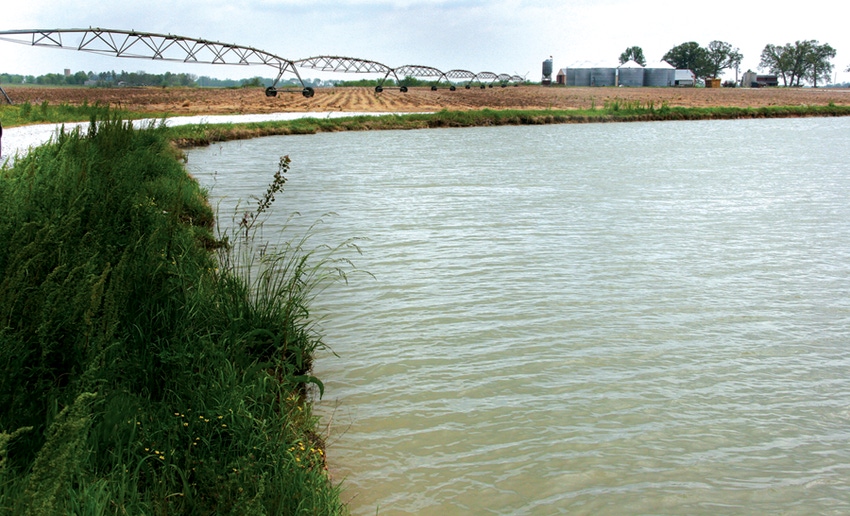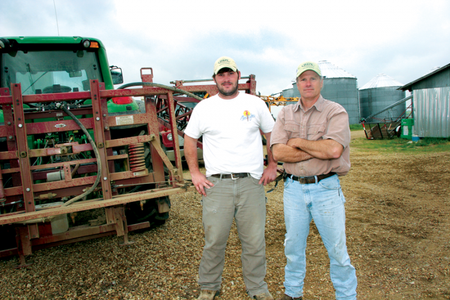
On their farms in the rolling prairie land of east central Mississippi’s Noxubee County not far from the Alabama line, the Huerkamps are racing a Good Friday witches’ brew of weather to get corn planted.
To the west, thunderstorms are building, some “possibly severe,” the weatherpersons say; 125 miles to the north, a fast-moving cold front is generating 2.5-inch hail and tornadoes. Rain is forecast for the weekend and into next week.

TYLER HUERKAMP with one of the center pivot systems fed from catchment ponds.
“Yesterday was the first time it’s been dry enough to get back in the field since we started planting,” says Joe Huerkamp. “This spring has been every farmer’s nightmare. We got about 40 percent of the corn planted and the weather went to pot, and now we’re faced with replanting a lot of it.”
Joe, his son, Tyler, his brother, Jack, and Jack’s son, Brandon, collectively and individually have six farms in the area, some as much as 15 miles apart, encompassing 3,600 acres. All are Mississippi State University graduates, with either ag economics or ag business degrees.
And while all their energies this day are concentrated on corn — Jack and Brandon are running spray rigs applying burndown herbicide, and Joe and Tyler are planting — the Huerkamps tell you right up front that they’re first and foremost cotton farmers.
“We plant corn for the cotton,” says Joe, taking a short break from the morning’s frantic activity. “We carry out a 50-50 cotton/corn rotation year-in, year-out. We didn’t back off that even when corn prices went sky high. Grains just don’t pay the bills the way cotton does. Cotton is in our blood.”
They’re a minority, though; this year, indications are there’ll probably be only 7,000 to 8,000 acres of cotton in the entire county — a far cry from the late 1800s, when Noxubee County was the largest cotton-growing county in Mississippi, with more than 100,000 acres.
“In the 1970s, when budworms and bollworms were eating up cotton and couldn’t be controlled, cotton was pretty much driven out of this area,” says Will McCarty, retired Mississippi Extension cotton specialist. “Farmers moved to soybeans, corn, livestock, or other ventures.
“Then, after the soybean bust in the early ’80s, some farmers began going back to cotton, and it has treated them very well, particularly in a cotton/corn rotation. These are very progressive growers, very innovative; they’re competitive with growers in the Delta in terms of yield and quality.”
“We started growing cotton in the early 1970s,” says Joe. “We got out for a while in the 1980s to grow soybeans, but we just couldn’t get the yields we needed, even with irrigation, so we went back to cotton. Ever since, we’ve been on the 50-50 rotation with corn, and that program has been good for us. The shredded cornstalks help build soil organic matter, and the cotton benefits from any residual nitrogen from the corn.
“We plant a cross-section of 10 different AgriGold, DeKalb, Terral, and Pioneer corn varieties. All are good, and we match a variety to a specific field. We’ll get around 125-150 bushels on the dryland corn, and 180 bushels or so on irrigated land. Last year, we averaged a bit over 170 bushels.”
Grain storage
They have 21 grain bins on their farms, with 228,000 bushels of storage.
“Cotton is 70 percent Deltapine 555, with some Stoneville,” Joe says, “and last year we had a 15-acre test plot for Deltapine’s Class of 2009 varieties, DP 0912 B2RF, DP 0935 B2RF, and DP 0924 B2RF. We were very pleased with all of them, and this year we’ll have a 15-acre test plot for their Class of 2010 varieties.

TAKING A BREAK during corn planting, Brandon Huerkamp (left) and Joe Huerkamp were racing the weather to get their 1,800 acres of corn seeded.
“Brent Gholston, local field advisor for Deltapine, bends over backwards to work with us on cotton.
“On the test plots last year, we got some 1,400- to 1,700-pound per acre yield equivalents,” Joe says. “Across 1,800 acres, we averaged 1,100 pounds.”
“555 has been a blessing for us,” says Tyler, who stops his big John Deere to chat a few moments. “We’ve planted some of that variety ever since it came out; it really comes on strong at the end of the season.”
Their harvested cotton makes a 65-mile trip to the nearest gin, Farmers Gin at Hamilton, Miss.
To achieve the consistently high cotton and corn yields they need, the Huerkamps are an irrigation salesman’s dream come true: They have 17 Valley and Zimmatic center pivot systems already in place and another on the ground waiting to go up. Most are a quarter-mile long and some water 200 acres.
Because well drilling in the area is prohibitively expensive, all the pivots are fed from 20- to 38-acrereservoirs through underground pipes that run 1,700 to 1,800 feet.
“A friend who’s in the well drilling business has drilled several wells for us,” says Tyler. “Our water table is around 1,000 feet; therefore, we only drill wells for supplemental water. I have one well close to 1,500 feet that only produces 300 gallons per minute. There’s just no way we could justify the cost of drilling the wells we’d need for all these center pivots.”
“Most of the lakes supply one pivot,” says Joe. “We can apply 4 inches to 5 inches per crop, and that’s enough to get us through a drought. We’ll suck most of the lakes dry during the season. All the lakes are located on poorer land in low-lying areas, with a system of terraces to divert water into them.
“I think I’ve probably bought my last system, but Tyler’s trying to get some more land, so he’ll probably add more pivots.”
Several of the systems have a Field Boss panel that allows the system to be programmed for variable rates and speeds to adjust for the rolling topography.
Catfish ponds
They also have about 80 acres in catfish ponds (Noxubee County is the second largest catfish producing area in Mississippi), but “the catfish are pretty much an afterthought in our operation,” says Joe. “The ponds are primarily for irrigation when needed.”
“It’s all about irrigation for us,” says Tyler. “About two years in 10 will be wet years, and the rest of the time the crops need supplemental water. We just couldn’t do what we do without irrigation.”
Conservation tillage also plays a role in their program.
“We try to plant on the same seedbed,” Tyler says. “Planting cotton behind corn, we’ll chisel down the rows and rebed on the same seedbed. The corn is no-till — all we do is shred the stalks, apply burndown, and plant, adding nitrogen as we go. This year, we did run a stalk puller because the cotton stalks from last season were so big.
“With last year’s sky-high fertilizer prices, we used only a small amount of dry fertilizer. Instead, we applied poultry litter, which we can get nearby, at 2 tons per acre, and that helped us hold the line on costs. The analysis was almost equivalent to commercial fertilizer, but the extra bulk takes more trips and more man-hours to apply — not to mention the smell and all the flies. But it saved a lot of money for us.”
They use a high wheel Hagie sprayer for chemical applications. “It’s one of the best investments we’ve ever made,” Tyler says. “It’s fast, smooth, and very versatile; with GPS, we can make very precise applications, with no waste.
“We’re just getting into GPS with the sprayer system, and we have new 20/20 Seed Sense planting monitor systems. The combine and cotton picker have AgLeader monitors and Jack has auto-steer on his tractor, so we’re going to start some field mapping in order to better utilize that feature.
“Everything about farming is getting so expensive, we’ve got to do everything we can to optimize yields,” says Tyler, who was recipient of the Mississippi Farm Bureau Young Farmer and Rancher Achievement Award for Region 6.
Joe and Jack’s father came to Mississippi from Ohio in the early 1960s and started farming in the area.
“I was three years old at the time,” says Joe, “so all I’ve ever known is South. There were six of us kids and we all came up in farming. Dad was in dairying for a long time. Thank heaven, he got out of that in 1975. I hope I never milk another cow as long as I live.
“We’ve been through some sure enough tough times. We went broke in the ’80s, when agriculture was on the ropes, going through its ‘restructuring,’ and it was cotton that pulled us out and got us going again.
“Cotton’s going through a rough spell now, but I think we’ll see it come back. As long as there’s a cotton infrastructure in place, it will be our mainstay crop.”
e-mail: [email protected]
About the Author(s)
You May Also Like




